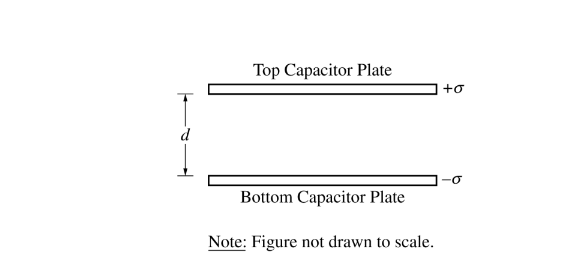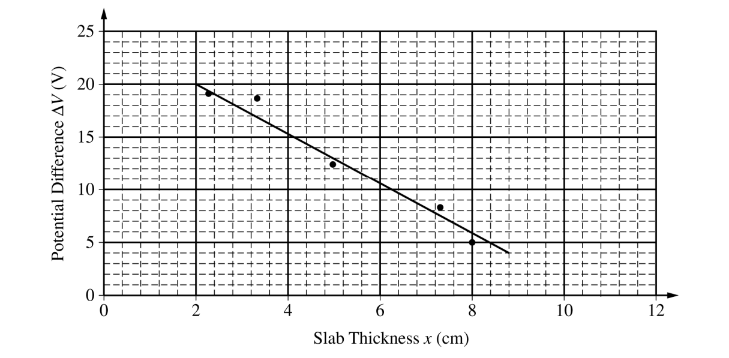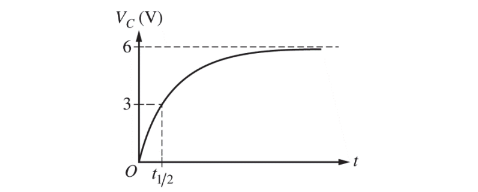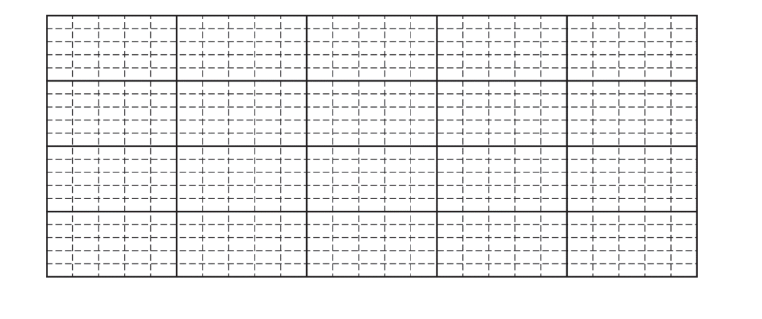Question

A parallel plate capacitor is connected to a battery, fully charged, and then isolated from the battery. The plates are given equal and opposite charge densities σ , and the separation between the plates is d, as shown in the figure above. The area of each plate has a value of A.
(a) Derive an expression for the energy stored in the capacitor. Express your answer in terms of σ , d, A, and physical constants, as appropriate.

While the capacitor is isolated from the battery, an uncharged metal slab of thickness x and area Ais inserted between the capacitor plates so that it is an equal distance from the two plates, as shown in the figure above.
(b) On the figure above, draw an arrow to indicate the direction of the electric field in the following three regions of space between the capacitor plates. If the electric field is zero in any region, indicate this by writing “E = 0” in that region.
i. The region between the top plate and the metal slab
ii. The region inside the metal slab
iii. The region between the metal slab and the bottom plate
(c) On the lines below, rank the regions according to the magnitude of the electric field, with 1 being the largest magnitude. If any regions have the same magnitude of electric field, give them the same ranking. The region between the top plate and the metal slab The region inside the metal slab The region between the metal slab and the bottom plate
(d) Is the capacitance of the capacitor with the metal slab greater than, less than, or equal to the capacitance of the original capacitor without the slab?
____ Greater than ____ Less than ____ Equal to
Justify your answer.
(e) When charged to the original charge density, is the energy stored in the capacitor with the metal slab greater than, less than, or equal to the original energy stored in the capacitor calculated in part (a) ?
___Greater than __________ Less than _______Equal to Justify your answer.
Some physics students conduct an experiment in which they charge the capacitor to the same potential difference, isolate it from the battery, insert the metal slab, and measure the new potential difference across the capacitor. This experiment is repeated with slabs of different thickness. The plot of the potential difference DV across the capacitor as a function of the thickness x of the slab is shown below. A best-fit line for the data has been drawn.

(f) Use the best-fit line to calculate the following:
i. σ , the charge density on the plates
ii. d, the distance between the capacitor plates
Answer/Explanation
For using an appropriate equation for calculating the energy stored in a capacitor\(U=\frac{q^2}{2C}\)
For substituting correctly into above equation
\(U=\frac{(\sigma A)^2}{2\frac{\varepsilon _{0}A}{d}}\)
Foe a correct answer
\(U=\frac{dA\sigma ^2}{2\varepsilon _{0}}\)
i)For properly drawing an arrow between the top plate and the metal slab pointing
downward
(ii)For indicating that E = 0 inside the metal slab
(iii) For properly drawing an arrow between the metal slab and the bottom plate pointing downward
(c) For ranking both regions between a plate and the metal slab as 1 and the region inside
the metal slab as 2
(d) For selecting “Greater than” with an attempt at a relevant justification 1 point For a correct justification 1 point Example: Inserting the metal slab effectively decreases the distance over which the electric field exists in the capacitor. Since the distance between the plates is effectively smaller, the capacitance is increased. Example: Inserting the metal slab decreases the extent of the electric field between the plates, which lowers the electric potential. If the electric potential between plates of a capacitor is lowered and the charge remains constant, the capacitance is increased.
(e)
For selecting “Less than” with an attempt at a relevant justification or for selecting an
answer consistent with part (d)
For a correct justification 1 point Example: Since the equivalent capacitance with the slab is greater than the original capacitance, and the energy stored is related to capacitance by \(U=q^2/(2c)\), the energy stored on the capacitor will be less with the metal slab.
(f) For correctly calculating the slope using appropriate values from the best-fit line
i)\(slope=\frac{\Delta V}{\Delta x}=\frac{(15-5)(V)}{(4.1-8.4)(\times 10^{-2}m)}=-232 V/m\)
For correctly relating the slope to the charge density on the plates
\(slope=-\frac{\sigma}{\varepsilon _{0}}\therefore \sigma =-(-232V/m)(8.85\times 10^{-12}C^2/(N.m^2))\)
\(\sigma =2.06\times 10^{-9}C/m^2\)
ii) For appropriately using the best fit line
\(V=\frac{\sigma (d-x)}{\varepsilon _{0}}\therefore (d-x)=\frac{V\varepsilon _{0}}{\sigma }\therefore d=x+\frac{V\varepsilon _{0}}{\sigma }\)
For an answer, with units, consistent with the charge density found above
\(d=0.02m+\frac{(20V)(8.85\times 10^{-12} C^2/(N.m^{2}))}{(2.06\times 10^{-9}C/m^{2})}\)
\(d=10.6cm\)
ii) Alternate solution
For using the extension of the best fit line to the x-axis
For an answer, with units, consistent with the extension of the line
d = 10.6 cm
Question

Students design an experiment to determine the unknown dielectric constant k of a plastic material. A capacitor is created using two square aluminum plates of side length s = 30 cm that are separated by a distance d = 1.0 mm. This capacitor is placed in a circuit with an ideal 6.0-volt battery, a resistor of resistance R = 500 W , voltmeter V, and an open switch S, as shown above. A 1.0 mm thick piece of plastic is inserted between the aluminum plates. The distance x that the plastic is inserted between the plates can be varied, and the voltmeter is used to measure the potential difference \(V_C\) across the capacitor. The switch is closed, and readings from the voltmeter are recorded as a function of time t. The data are plotted to create the graph shown below.

The time \(t_{1/ 2}\) shown above is the time for the capacitor to charge to half the potential difference of the battery.
(a) The potential difference across the capacitor as a function of time is modeled by the equation \(V_c=V_{Max}(1-e^{-t/RC})\),where \(V_{Max}=6V\). Derive an expression for the capacitance C of the capacitor. Express your answer in terms of \(t_{1/ 2}\) , R, and physical constants, as appropriate. The data for x and\(t_{1/ 2}\) are recorded for several trials and the value of C for each trial is calculated. The results are shown in the chart below.

(b) Plot the experimental value of the capacitance C as a function of the distance x on the graph below. Clearly scale and label all axes, including units if appropriate. Draw a straight line that best represents the data.

(c) The capacitor in the lab can be treated as two capacitors in parallel, one with the dielectric and one with air between the plates. Show that the capacitance can be expressed as \(C=\frac{\varepsilon _{0}s}{d}(s+x(k-1))\).
(d) Using the graph from part (b), calculate the value of the dielectric constant k .
(e) The students now want to verify the value for the permittivity constant,\( \varepsilon _0 \). Using the graph from part (b), calculate an experimental value for \(\varepsilon _0\) .
(f) Assume the value found in part (e) is higher than the accepted value for the permittivity constant. State one possible physical reason for this error and explain how it could have caused this error.
Answer/Explanation
(a) For correctly substituting into given equation
\(V_c=6(1-6^{-6/RC})\therefore 3=6(1-e^{-t_{1}/RC})\)
For correctly solving the above equation
\(\frac{3}{6}=1-e^{-t_{1}/RC})\therefore e ^{t_{\frac{1}{2}}/RC}=\frac{1}{2}\therefore -t_{\frac{1}{2}}/RC=ln(\frac{1}{2})\)
\(C=\frac{t_{\frac{1}{2}}}{R ln(2)}\)
Note: Answer point is earned with or without a negative sign
(b) For using a correct scale that uses more than half the grid and for correctly labeling the axes including units as appropriate For correctly plotting the data For drawing a straight line consistent with the plotted data
(c) For indicating that the capacitance is equal to the sum of the part with a dielectric and the part with air \(C = C_x + C_o \)For correctly substituting for the part of the capacitor that has a dielectric For correctly substituting for the part of the capacitor that has air \(C =\frac{KEOSX}{d}+\frac{\varepsilon _OS (s – x)} {d}(Kx+s-x)=\varepsilon_ {O}S{d} (s + x(k − 1))\)
(e) For using an acceptable value for the y-intercept consistent with the best-fit line For correctly relating the y-intercept to the permittivity constant \(C=\frac{\varepsilon _0s^2}{d}+\frac{\varepsilon _0s(k-1)}{d}x\therefore y -intercept=\frac{\varepsilon _0s^2}{d}
\varepsilon _0=\frac{(d)(y -intercept)}{s^2}=\frac{\left ( 1\times 10^{-3}m \right )\left ( 8.4\times 10^{-10}F \right )}{(.3m)^2}=9.29\times 10^{-12}C^2/(N.M^2)\)
(f) For a correct explanation of an acceptable physical issue Claim: The resistance in the wires would cause the experimental value to be higher than the accepted value of the permittivity constant.
Evidence: The potential difference across the capacitor would be smaller.
Reasoning: The wires could have nonnegligible resistance.
Alternate Explanation
Claim: The air between the plates of the capacitor would cause the experimental value to be higher than the accepted value of the permittivity constant.
Evidence: The air between the plates of the capacitor increases its capacitance.
Reasoning: The air between the plates of the capacitor act as a dielectric.
